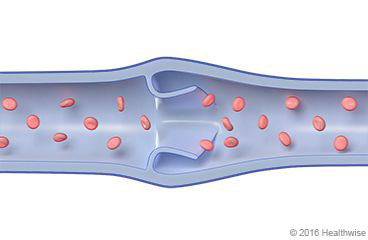
Overview
Factor V Leiden is the most common inherited condition that causes an increase in blood clotting. It increases the chances that your blood will form abnormal blood clots that can be dangerous. Clots can form in the veins near your bones that carry a lot of blood (deep veins), a condition called deep vein thrombosis. A clot can travel through the blood to a lung and cause a serious problem called a pulmonary embolism.
Many things can increase the chance of blood clots, including smoking and not being able to walk or move around for a long time. Your treatment may include a medicine (called a blood thinner) that prevents blood clots. A healthy lifestyle also can lower your risk of a blood clot.
Factor V Leiden is caused by a faulty gene that you inherit from one or both parents. Talk with your doctor about whether other people in your family should be tested for the faulty gene.
Follow-up care is a key part of your treatment and safety. Be sure to make and go to all appointments, and call your doctor if you are having problems. It's also a good idea to know your test results and keep a list of the medicines you take.
How can you care for yourself at home?
- Take your medicines exactly as prescribed. Call your doctor if you think you are having a problem with your medicine.
- If you take a blood thinner, be sure you get instructions about how to take your medicine safely. Blood thinners can cause serious bleeding problems.
- Let doctors you see know that you have factor V Leiden.
- Wear medical alert jewelry that lists your clotting problem. You can buy it online or at most drugstores.
- Check with your doctor about whether you should use hormone forms of birth control or hormone therapy. These may increase your risk of blood clots.
- Try not to sit or lie down for long periods. If you are in bed at home recovering from an injury or surgery, ask your doctor how often you should move around or do exercises. If you are on a long car trip, stop every hour or so. Get out and walk around for a few minutes. If you are traveling by bus, train, or plane, walk up and down the aisle every hour or so.
- Have a healthy lifestyle.
- Stay at a healthy weight. Lose weight if you need to.
- Eat a healthy diet.
- Get at least 30 minutes of exercise on most days of the week. Walking is a good choice. You also may want to do other activities, such as running, swimming, cycling, or playing tennis or team sports.
- Do not smoke. It can increase the risk of blood clots. If you need help quitting, talk to your doctor about stop-smoking programs and medicines. These can increase your chances of quitting for good.
When should you call for help?
Call 911 anytime you think you may need emergency care. For example, call if:
- You have symptoms of a blood clot in your lung (called a pulmonary embolism). These include:
- Sudden chest pain.
- Trouble breathing.
- Coughing up blood.
Call your doctor now or seek immediate medical care if:
- You have signs of a blood clot in your arm or leg. These may include:
- Pain in your arm, calf, back of the knee, thigh, or groin.
- Redness and swelling in your arm, leg, or groin.
Watch closely for changes in your health, and be sure to contact your doctor if you have any problems.
Current as of: October 7, 2025
Author: Ignite Healthwise, LLC Staff
Clinical Review Board
All Ignite Healthwise, LLC education is reviewed by a team that includes physicians, nurses, advanced practitioners, registered dieticians, and other healthcare professionals.

